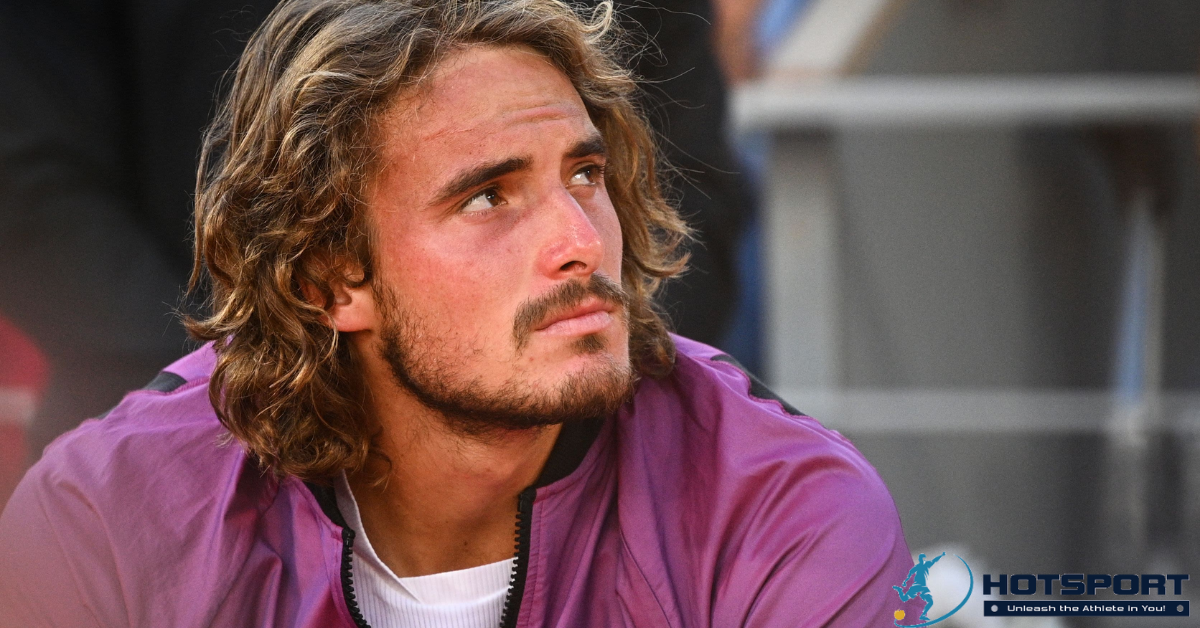Stefanos Tsitsipas: The Greek Tennis Player Conquering the World
Stefanos Tsitsipas is one of the most prominent names in contemporary world tennis. Born in Greece, he represents not only his country but also a new generation of players who combine technical talent with personal charisma. With a career marked by impressive victories and overcome challenges, Tsitsipas has established himself as a top competitor on the ATP circuit. This article explores his journey, from his first steps to his most recent achievements, highlighting aspects of his life and career.
Early Biography
Family Origins and Childhood
Stefanos Tsitsipas was born on August 12, 1998, in Vouliagmeni, a coastal region of Athens, Greece. The son of Apostolos Tsitsipas, a Greek tennis coach, and Julia Apostoli (née Salnikova), a former Russian tennis player who reached the WTA top 200 and was the number one Soviet junior, Stefanos grew up in a sports-centric environment. His parents met during a WTA tournament in Athens, where Apostolos worked as a line judge. The family includes three siblings—Petros, Pavlos (Paul), and Elisavet—all involved in tennis.
Tsitsipas’ maternal grandfather, Sergei Salnikov, was a legendary figure in Russian football, an Olympic gold medalist in 1956 and a director at FC Spartak Moscow. This sporting heritage deeply influenced Stefanos, who began playing with rackets at age three, hitting balls with his father during breaks from lessons. Besides tennis, he tried football and swimming but chose tennis at six, starting lessons at the Tennis Club Glyfada near Athens.
At nine, after competing in a tournament in France, Tsitsipas told his father he dreamed of becoming a professional. Fueled by a passion for competition, he dedicated himself fully. In 2015, he moved to the Patrick Mouratoglou Academy in France, splitting training between Greece and Europe, honing his skills in a high-performance environment.
Influences and Development
Tsitsipas’ development was shaped by family discipline and a multicultural background. Fluent in Greek, English, and Russian, he absorbed diverse cultures, enriching his worldview. His father, Apostolos, has been a central figure in his career, serving as his primary coach at various points. This father-son dynamic brought both benefits and challenges, as explored later.
Junior Career
Tsitsipas emerged on the ITF junior circuit in 2013 at age 14. Despite a late start in elite tournaments, he showed promise by reaching the 2014 Orange Bowl final, even outside the top 100. In 2015, he competed in his first junior Grand Slam at the Australian Open, reaching the quarterfinals, and ended the year as world number 14.
The year 2016 was pivotal: Tsitsipas reached at least the quarterfinals in every tournament he played, including all four Grand Slams. He won the Trofeo Bonfiglio and the European Junior Championships. In doubles, alongside Kenneth Raisma, he claimed Wimbledon, becoming the first Greek to win a junior Grand Slam in the Open Era since Nicky Kalogeropoulos in 1963. He finished the year as world number 2, behind only Miomir Kecmanović, and later reached the top of the junior rankings.
This junior phase solidified his technical and mental foundation, preparing him for the professional transition.
Early Professional Career
ITF and Challenger Circuits
Tsitsipas began his professional journey in 2013 at ITF tournaments in Greece, shortly after turning 15. In 2015, he qualified for his first ATP Challenger at the Burnie International but lost in the main draw. That year, he won his first Futures title, amassing 11 titles by 2016 (five in singles, six in doubles).
In 2016, he reached Challenger finals in Mohammedia and Casablanca, entering the top 200 in October. He received a wildcard for the Basel ATP qualifying, defeating Rajeev Ram but failing to advance. In 2017, he debuted in the main draw at Rotterdam, losing to Jo-Wilfried Tsonga. At the French Open, he fell in qualifying to Ivo Karlovic. He won his first Challenger in Genova and reached the Antwerp semifinals, defeating top-10 player David Goffin, becoming the first Greek in the ATP top 100 at age 19. He ended 2017 with another Challenger final in Brest.
Breakthrough in 2018
The year 2018 marked a turning point. In Doha, Tsitsipas reached the quarterfinals against Dominic Thiem. After a first-round loss at the Australian Open, he shone at the Barcelona ATP, reaching his first ATP final without dropping a set, defeating three top-20 players, including Thiem, but losing to Rafael Nadal. He entered the top 50. At the Toronto Masters, he defeated four consecutive top-10 players (Thiem, Djokovic, Zverev, and Anderson), reaching the final against Nadal—the youngest to achieve this since 1990. He won his first ATP title in Stockholm against Ernests Gulbis and the Next Gen ATP Finals in Milan. He finished the year in the top 15.
Establishing Stardom
2019-2020: First Major Achievements
In 2019, Tsitsipas won ATP titles in Marseille and Estoril and reached the Australian Open semifinals, defeating Roger Federer in the fourth round—his first win against a Big Three member. At the Madrid Masters, he beat Nadal in the semifinals. He won the ATP Finals in London, defeating Thiem in the final, becoming the youngest champion since 2001. He ended the year as world number 6.
The 2020 pandemic disrupted the circuit, but Tsitsipas maintained his level, reaching the US Open and French Open semifinals, losing to Djokovic in five sets at the latter. In 2021, he won his first Masters 1000 title in Monte Carlo and reached the French Open final, leading Djokovic by two sets but losing in five. In 2022, he defended Monte Carlo, won Mallorca, and reached the Australian Open semifinals.
2021-2023: Peak and Consistency
Tsitsipas reached world number 3 in 2021. He won Lyon and reached finals in Barcelona and Rome. In 2022, he won Monte Carlo again and Astana, and reached the Australian Open final in 2023, losing to Djokovic. He also won Los Cabos. His one-handed backhand became an iconic weapon, and he racked up wins against top players.
Recent Challenges and Achievements (2024-2025)
Injuries and Inconsistencies
In 2024, Tsitsipas faced inconsistencies but won Monte Carlo for the third time. Elbow and back injuries required minor surgery, impacting his performance. He ended the year in the top 10 but with fewer titles.
In 2025, he experienced highs and lows. He won the Dubai title in March, defeating Felix Auger-Aliassime 6-3, 6-3. He reached the Roland Garros final, feeling “blessed” to be a Slam finalist again, but lost to Carlos Alcaraz in an epic match. However, a back injury forced him to retire in the first round of Wimbledon against Valentin Royer, leaving him “without answers” and questioning his motivation.
Coaching Changes
In June 2025, Tsitsipas hired Goran Ivanisevic, former Wimbledon champion, as his coach, seeking inspiration. They worked together in Halle, where Tsitsipas learned “a lot every day.” However, after disappointing results, including a loss in Cincinnati, they parted ways in July in a “brief but intense” experience. Tsitsipas rehired his father, Apostolos, marking a return to his roots.
Current Form and Ranking
As of August 2025, Tsitsipas has a 21-17 record, with strong performances on hard courts (10-7) and clay (Dubai title, Paris final). His ranking slipped outside the top 20, the lowest since 2018, due to inconsistencies. In Winston-Salem, as the top seed, he debuted against rising Chinese player Yunchaokete Bu on August 19, prevailing in an epic match, showing signs of recovery.
Tsitsipas has 13 ATP singles titles, including three Monte Carlo Masters, the 2019 ATP Finals, and several ATP 500s. His Grand Slam record includes two Australian Open finals (2023), one French Open final (2021), another in 2025, and semifinals at Wimbledon and the US Open.
Playing Style
Tsitsipas is known for his aggressive, versatile game. His powerful forehand and rare one-handed backhand are key weapons. He excels on clay, where his mobility and consistency shine, but is also effective on hard courts. His 1.93m height aids his serve, often exceeding 200 km/h. Mentally resilient, he uses varied tactics like slices and drop shots to disrupt opponents.
His weaknesses include inconsistency in crucial moments and recurring injuries, which impact his confidence.
Personal Life
Off the court, Tsitsipas is multifaceted. Fluent in three languages, he enjoys philosophy, photography, and travel. He runs a YouTube channel sharing vlogs about his life on tour, revealing an introspective side. He dated Spanish tennis player Paula Badosa, but their relationship ended amicably in 2024.
Tsitsipas is an ambassador for brands like Adidas and Rolex and supports social causes, such as aiding Greek refugees. His family remains central, with his siblings active in junior tennis.
Controversies
Tsitsipas has faced criticism for long breaks during matches, perceived as tactics to disrupt opponents’ rhythm. In 2021, Andy Murray accused him of “unfair play” at the US Open. He sparked debate by questioning vaccines during the pandemic but later got vaccinated. His on-off coaching relationship with his father, including a public split in 2023, has drawn attention, though reconciliations highlight their strong bond.
Legacy and Future
At 27, Tsitsipas is already Greece’s greatest tennis player, inspiring young athletes in his country. With over 300 ATP wins and prize money exceeding $30 million, he has broken barriers for smaller tennis nations.
Looking ahead, 2025 is a turning point. With his father back as coach and a focus on health, Tsitsipas aims to return to the top 10 and win a Grand Slam. His resilience and talent suggest more exciting chapters lie ahead.
In summary, Stefanos Tsitsipas embodies Greek determination on the global stage. His journey, filled with highs and lows, continues to captivate fans worldwide, proving that tennis is more than a game—it’s a story of perseverance.



